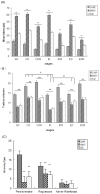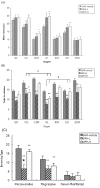Effects of methylphenidate on attentional set-shifting in a genetic model of attention-deficit/hyperactivity disorder
- PMID: 22369105
- PMCID: PMC3312818
- DOI: 10.1186/1744-9081-8-10
Effects of methylphenidate on attentional set-shifting in a genetic model of attention-deficit/hyperactivity disorder
Abstract
Background: Although deficits of attentional set-shifting have been reported in individuals with attention deficit/hyperactivity disorder (ADHD), it is rarely examined in animal models.
Methods: This study compared spontaneously hypertensive rats (SHRs; a genetic animal model of ADHD) and Wistar-Kyoto (WKY) and Sprague-Dawley (SD) rats (normoactive control strains), on attentional set-shifting task (ASST) performance. Furthermore, the dose-effects of methylphenidate (MPH) on attentional set-shifting of SHR were investigated. In experiment 1, ASST procedures were conducted in SHR, WKY and SD rats of 8 each at the age of 5 weeks. Mean latencies at the initial phase, error types and numbers, and trials to criteria at each stage were recorded. In experiment 2, 24 SHR rats were randomly assigned to 3 groups of 8 each-- MPH-L (lower dose), MPH-H (higher dose), and SHR-vehicle groups. From 3 weeks, they were administered 2.5 mg/kg or 5 mg/kg MPH or saline respectively for 14 consecutive days. All rats were tested in the ASST at the age of 5 weeks.
Results: The SHRs generally exhibited poorer performance on ASST than the control WKY and SD rats. Significant strain effects on mean latency [F (2, 21) = 639.636, p < 0.001] and trials to criterion [F (2, 21) = 114.118, p < 0.001] were observed. The SHRs were found to have more perseverative and regressive errors than the control strains (p < 0.001). After MPH treatment, the two MPH treated groups exhibited significantly longer latency and fewer trials to reach criterion than the SHR-vehicle group and the MPH-L group exhibited fewer trials to reach criterion in more stages compared with the MPH-H group. Significant main effects of treatment [F (2, 21) = 52.174, p < 0.001] and error subtype [F (2, 42) = 221.635, p < 0.01] were found.
Conclusions: The SHR may be impaired in discrimination learning, reversal learning and attentional set-shifting. Our study provides evidence that MPH may improve the SHR's performance on attentional set-shifting and lower dose is more effective than higher dose.
Figures


Similar articles
-
Effect of methylphenidate treatment during adolescence on norepinephrine transporter function in orbitofrontal cortex in a rat model of attention deficit hyperactivity disorder.J Neurosci Methods. 2015 Aug 30;252:55-63. doi: 10.1016/j.jneumeth.2015.02.002. Epub 2015 Feb 11. J Neurosci Methods. 2015. PMID: 25680322 Free PMC article.
-
Performance on a strategy set shifting task during adolescence in a genetic model of attention deficit/hyperactivity disorder: methylphenidate vs. atomoxetine treatments.Behav Brain Res. 2013 May 1;244:38-47. doi: 10.1016/j.bbr.2013.01.027. Epub 2013 Jan 31. Behav Brain Res. 2013. PMID: 23376704 Free PMC article.
-
Strain differences in self-administration of methylphenidate and sucrose pellets in a rat model of attention-deficit hyperactivity disorder.Behav Pharmacol. 2011 Dec;22(8):794-804. doi: 10.1097/FBP.0b013e32834d623e. Behav Pharmacol. 2011. PMID: 22015805 Free PMC article.
-
Drug reinforcement in a rat model of attention deficit/hyperactivity disorder--the Spontaneously Hypertensive Rat (SHR).Curr Drug Abuse Rev. 2009 May;2(2):177-83. doi: 10.2174/1874473710902020177. Curr Drug Abuse Rev. 2009. PMID: 19630747 Review.
-
Systematic review and meta-analysis of the behavioral effects of methylphenidate in the spontaneously hypertensive rat model of attention-deficit/hyperactivity disorder.Neurosci Biobehav Rev. 2019 May;100:166-179. doi: 10.1016/j.neubiorev.2019.02.019. Epub 2019 Feb 28. Neurosci Biobehav Rev. 2019. PMID: 30826386
Cited by
-
Methylphenidate administration promotes sociability and reduces aggression in a mouse model of callousness.Psychopharmacology (Berl). 2019 Sep;236(9):2593-2611. doi: 10.1007/s00213-019-05229-9. Epub 2019 Apr 6. Psychopharmacology (Berl). 2019. PMID: 30955107
-
Found in translation: Understanding the biology and behavior of experimental traumatic brain injury.Neurosci Biobehav Rev. 2015 Nov;58:123-46. doi: 10.1016/j.neubiorev.2014.12.004. Epub 2014 Dec 10. Neurosci Biobehav Rev. 2015. PMID: 25496906 Free PMC article. Review.
-
Development of a peptide targeting dopamine transporter to improve ADHD-like deficits.Mol Brain. 2018 Nov 9;11(1):66. doi: 10.1186/s13041-018-0409-0. Mol Brain. 2018. PMID: 30413217 Free PMC article.
-
Chronic administration of pharmacological doses of angiotensin 1-7 and iodoangiotensin 1-7 has minimal effects on blood pressure, heart rate, and cognitive function of spontaneously hypertensive rats.Physiol Rep. 2021 Apr;9(7):e14812. doi: 10.14814/phy2.14812. Physiol Rep. 2021. PMID: 33904655 Free PMC article.
-
Baseline-dependent effects of amphetamine on attention are associated with striatal dopamine metabolism.Sci Rep. 2017 Mar 22;7(1):297. doi: 10.1038/s41598-017-00437-9. Sci Rep. 2017. PMID: 28331177 Free PMC article.
References
-
- Chamberlain SR, Robbins TW, Winder-Rhodes S, Muller U, Sahakian BJ, Blackwell AD. et al.Translational approaches to frontostriatal dysfunction in attention-deficit/hyperactivity disorder using a computerized neuropsychological battery. Biol Psychiatry. 2010;69:1192–1203. - PubMed
-
- Kado Y, Sanada S, Yanaqihara M, Ogino T, Abiru K, Nakano K. et al.Clinical application of the modified wisconsin card sorting test to children with attention deficit/hyperactivity disorder. No To Hattatsu. 2005;37:380–385. - PubMed
Publication types
MeSH terms
Substances
LinkOut - more resources
Full Text Sources
Medical

